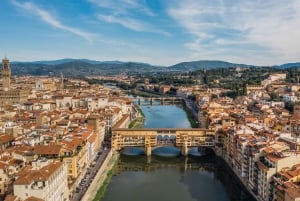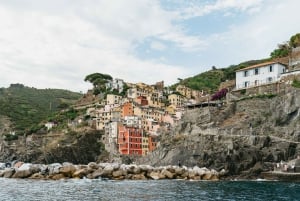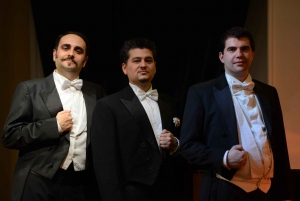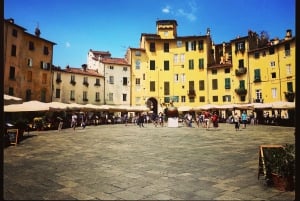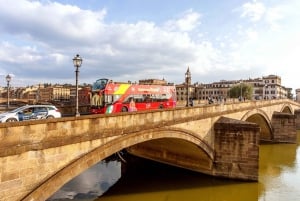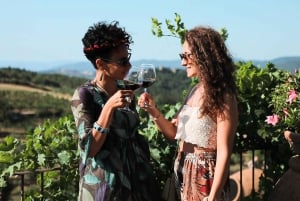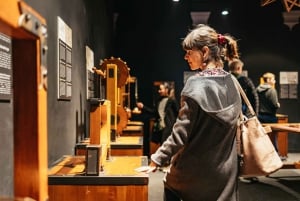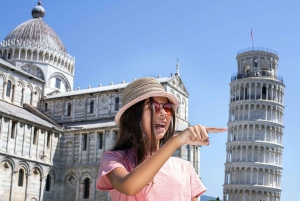Traditions
Florence has a lot of holidays. Some statutory, some local, some religious, some… just silly. Some come with flag throwers, others with museum closures, and all come with an interesting history. Here is a list of the holidays in Florence, their history and what to expect.
The Procession of the Magi (Epiphany - 6 January)
Every year, on 6 January, a solemn procession inspired by Benozzo Gozzoli’s celebrated fresco in the Chapel of the Magi in Palazzo Medici Riccardi winds its way through the ancient streets of the city centre to celebrate the feast of the Epiphany, which recalls the journey made by the Magi to pay homage to the Infant Jesus. Dressed in magnificent costumes, the Magi, accompanied by the Procession of the Republic of Florence, take a route that starts in Piazza Pitti, passes through the ancient streets and ends in Piazza del Duomo Inside the Cathedral of Santa Maria del Fiore the Magi offer gifts to the image of the Infant Jesus, while the Opera del Duomo distributes presents to all the children taking part.
Special openings and guided tours of Palazzo Medici Riccardi, and especially of the Chapel, are organized for the occasion.
Bursting of the cart (Easter Sunday) - Piazza Duomo
The ceremony that gave rise to the modern-day Scoppio del Carro (‘bursting of the cart’) officially became public in 1102, at a time when the Pazzi family enjoyed great fame and prestige, partly as a result of Pazzino’s heroic deeds during the First Crusade (1096). However, the Pazzi family were stripped of all their wealth and privileges, and exiled from Florence, after their aborted attempt to overthrow the Medici in 1478. From that moment on, the Signoria took over responsibility for the preparation and celebration of the ritual explosion of the cart. The ritual has not altered over the years. The richly decorated cart, which dates to the 18th century, is hauled by gaily decorated oxen from Porta al Prato to the cathedral square. A wire is run from the choir of the cathedral and fixed to the centre of the cart. In the meantime a procession of clergy leaves the Church of the Santissimi Apostoli and goes to the Baptistery for a religious function. A dove-shaped rocket is released inside the cathedral; it slides along the wire, leaving a trail of smoke along the length of the nave. When it reaches the cart, it sets off a cluster of crackers, and then slides back to its point of departure. After a few moments, hundreds of multicoloured fireworks positioned on the cart go off, accompanied by cracks and whistles. A Catherine wheel on top lights up and starts spinning, ending with a loud bang and opening up to form the petals of a lily. Then four small gonfalons appear, bearing the emblems of Florence, of the old Pazzi family, of the Wool Merchants’ Guild and currently, as a sign of peace in the world, of the UN.
The Festa del Grillo (Ascension Sunday) – Cascine Park
The origins of the Festa del Grillo (‘Feast of the Cricket’) lie in ancient pagan festivities celebrating the arrival of spring. Later, the city used to celebrate May with the ‘Calendimaggio’: young men adorned the doors or windows of their sweethearts with flowers, and gave them a cricket in a small cage made from broom wood. According to popular tradition, a "chirping" cricket brought good luck and protected the household.
Calcio Storico (June, final on 24 June) – Piazza Santa Croce
In ancient Florentia the Romans played this game as a way of getting their legionnaires into shape.
The most memorable and famous game of ‘Calcio in Livrea’ (‘Football in livery’) took place on 17 February 1530 in Piazza Santa Croce, between the ‘Whites’ and the ‘Greens’, while the city was under siege by Imperial troops. Originally, the players were fine-looking ‘gentlemen’ of good
reputation who dressed in magnificent garb. The games took place during Carnival and important commemorative events. Many members of the Medici family and various Grand Dukes of Tuscany
played at one time or another.
Historic Football, otherwise known as Football in Costume, was played in the city’s most important piazzas until the 18th century. The tradition then lapsed until May 1930 (the fourth centenary of the siege of Florence). Three games are now played each year: two semi-finals and a final, which takes place on 24 June, the Feast of Saint John the Baptist, patron saint of Florence. The matches, which are held in Piazza Santa Croce, are preceded by a historic procession through the city centre streets by over 500 participants in the typical dress of the 16th century. The competition is between the four historic quarters of the city: San Giovanni (‘Greens’), Santa Maria Novella (‘Reds’), Santa Croce (‘Blues’) and Santo Spirito (‘Whites’). In calcio storico the equivalent of a goal is a caccia. The winning team is awarded a calf. Info: 0552616052.
The Feast of Saint John (24 June)
According to ancient accounts, Saint John the Baptist became the patron saint of Florence in the Lombard age, and was a dominant presence in the city’s life for centuries. Religious and civic ceremonies were organized to pay solemn tribute to him, and also to affirm the power of Florence in the eyes of the world at large. The Baptistery was built in his honour, and in ancient times heralds would announce the various festivities in key points around the city, while the nobles and upper classes were notified of their obligation to make offerings of candles. Some of the candles donated to Saint John were then used through the year in the Baptistery. As Florence’s power increased, the candles became enormous and more and more richly decorated. Even today, on the morning of 24 June a small procession goes from Palazzo Vecchio to offer up candles to the city’s patron saint.
However, the biggest attraction for Florentines nowadays is the firework display (the fuochi di San Giovanni) that takes place in Piazzale Michelangelo in the evening. The show, which lasts about an hour and ends with a final "big bang", draws huge crowds, especially along the river.
The Rificolona (evening of 7 September) – Piazza Santissima Annunziata
The Rificolona, which is mainly for children, takes place in Piazza Santissima Annunziata on the evening of 7 September, the eve of the birth of the Virgin Mary. Some historians claim this festivity originated with the arrival in Florence of peasants and mountain folk from the Casentino and the Pistoian Mountains, who made the long journey to the city because they wanted to celebrate the religious occasion in the Florentine church of Santissima Annunziata. The fair that took place in the same piazza on 8 September also provided an opportunity to sell their produce. The peasants lit their path with torches and lanterns of various shapes, which they continued to use once they arrived in the city. Drawing inspiration from these lanterns, the Florentines began to make the first rificolone (paper puppets with lamps inside) using the same bright colours as the clothes worn by the mountain people. The shape of these puppets gradually changed, and they started to be hung from house windows, creating an unusual and rather special atmosphere.
Palio del Baluardo - crossbow archery contest
The Palio del Baluardo is held every year, usually the third Sunday in May, at the bastion called the Fountain of Geneva (home of the Archers listed as part of the historical parade in via di Belvedere). It is a traditional archery competition with crossbow, which is meant to celebrate a historic date for the city of Florence, May 16, 1527. On that date the Florentines drove out the Medici family and proclaimed the republic, which lasted only until August 12, 1530, when the
the city the city surrendered to the siege of the Emperor Charles V troops.
Il Baluardo a San Giorgio - via di belvedere, close to Porta San Giorgio and Forte Belvedere - tel. 0552616051 - info@ibalestrieridifirenze.it free admission
Festa di Sant'anna
Celebrating Sant’Anna was once almost as important as celebrating San Giovanni in Florence but the tradition was completely forgotten until about seven years ago when the City of Florence decided to reinvent this festival that was once so important. The celebration consists of a solemn ceremony in honour of the saint deemed the "protector of Florence’s freedom"and a parade across town which leaves from the Palagio di Parte Guelfa and goes through to Piazza della Signoria around 21.30.Then the parade crosses town with final arrival at the Church of Orsanmichele around 22.00 where there is the Benediction and lighting of the candle.At 24.00 the Parade returns to the Palagio di Parte Guelfa.
Tradition/Bacco Artigiano Carro Matto
A wonderful opportunity to see history reenacted in Florence's historic centre. The Bacco Artigianato Carro Matto is the traditional post-harvest ceremony of blessing and offering of wine to Florence's remaining bluebloods by Tuscan farmers. Beginning at 3:30pm, the Historical Court of the Florentine Republic and parade of the Carro Matto (the ‘crazy cart') arrives in piazza Signoria from piazza Strozzi. The wine is then be blessed by the religious authorities of Santa Maria del Fiore (the Duomo), and the parade continues to the San Carlo dei Lombardi church on via Calzaiuoli, where the wine is offered to the court. Concert of early music and sale of traditional demijohns to follow.
Festa di Santa Reparata
According to the legend, Saint Reparata had been seen hovering over the city during the first attack of the Ostroghts (406 AD). The city fiercely resisted under the siege of the Barbarians and the Florentines attributed their liberation to the Saint. As a result Florence decided to re-enact the episode on October 8, the feast of the saint. The fifth-century Florentines also decided to dedicate to the saint the first cathedral they were to build, the remains of which can still be seen beneath the present-day cathedral and dedicated to Santa Maria del Fiore. Nowadays the celebrations linked to Santa Reparata are the occasion for rediscovering classical Florentine culture. In the morning of October 8, guided tours to the "Roman" Florence and "Roman" museums of Florence are held to explore the remains of Florence‘s first Christian years. A conference (in Italian) on the subject is held in Palazzo Vecchio at 16.30 . The procession of a representation of the Court of the Florentine Republic then leaves at18.30 from Piazzetta di Parte Guelfa and ends in Santa Maria del Fiore, where a moving ceremony is held in Santa Reparata’s crypt.
Festa degli Omaggi e Corteo della Repubblica FIORENTINA
The Festa degli Omaggi, on December 20, is another time-honoured Florentine tradition. Men in tights bidding good tidings and teams of flag-throwers parade around town with
the Florentine brass band ' greeting civil and religious authorities Leaving Palagio di Parte Guelfa at 16.00 through Porta Rossa, Piazza San Giovanni, Palazzo Medidi Riccardi, Duomo, Piazza Signoria, Palazzo Vecchio and back to Palagio di Parte Guelfa at around 18.30
Also outside Florence you will find a lot of holidays of different kind: traditional, religious and also scoffing!
Palio di Siena
The Palio di Siena is a horse race held in Siena twice a year: on July 2 and August 16. In these occasions there are ten bareback horses and riders, dressed in the appropriate colours that represent ten of the seventeen contrade of the city. The first palio (July 2) is the Palio di Provenzano (in honour of the Madonna of Provenzano), while the other (August 16) is called Palio dell'Assunta (in honour of the Assumption of Mary). Before the race a wonderful historical parade, in rich medieval costumes, make a procession around Piazza del Campo, where the race is held on a thick layer of earth displaced on the ground. It is not unusual for a the jockey to be thrown off his horse, and sometimes it happens that an unmounted horse finish its race without jockey.
Carnival of Viareggio
The Carnival of Viareggio is a great and funny event held in Viareggio, a town near Lucca. It is considered as one of the most important and famous carnival celebrations in Italy. Its main attraction is the parade of carnival floats and masks made of papier-mache that takes place along the seafront. The floats here are true works of art made by artisans which dedicate them an entire year of work. They usually represent the caricatures of famous people, mainly politicians, and have an allegorical meaning. Each float is full of people, especially children, that throw confetti and paper streamer. Furthermore, during the carnival period, there are amazing parties in the various districts (rioni) of the town.
Palla Grossa
In Prato, a city very close to Florence, every year, from September 9 to September 15, is held a very funny centuries-old soccer tournament: the Palla Grossa. It is a competition among the four districts of Prato: the Reds of Santa Trinita, the Greens of San Marco, the Yellows of Santo Stefano and the Blues of Santa Maria. They play for 60 minutes in the splendid arena of Piazza Mercatale.
The Saracen Joust of Arezzo
This is an ancient game of chivalry that dates back to the Middle Ages. It takes place every year in Arezzo on the last Saturday of June by night and on the first Sunday of September, in the afternoon. The four districts of Arezzo compete in pairs as jousters against the Saracen, an armor-plated dummy representing a Saracen. The competition is won by the knights who obtain the maximum score in hitting the Saracen’s shield . For more information:
www.giostradelsaracino.arezzo.it


